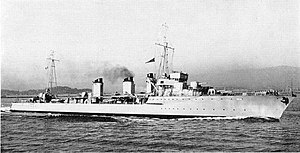 Chacal before 1940
| |
| Class overview | |
|---|---|
| Name | Chacal or Jaguar |
| Operators | |
| Succeeded by | Guépard class |
| Completed | 6 |
| Lost | 5 |
| Scrapped | 1 |
| General characteristics (as built) | |
| Type | Large destroyer |
| Displacement |
|
| Length | 126.8 m (416 ft 0.1 in) |
| Beam | 11.1 m (36 ft 5.0 in) |
| Draft | 4.1 m (13 ft 5.4 in) |
| Installed power |
|
| Propulsion |
|
| Speed | 35.5 knots (65.7 km/h; 40.9 mph) |
| Range | 3,000 nmi (5,600 km; 3,500 mi) at 15 knots (28 km/h; 17 mph) |
| Crew | 12 officers, 209 crewmen (wartime) |
| Armament |
|
The Chacal-class destroyer, sometimes known as the Jaguar class, were a group of six large destroyers (contre-torpilleurs) built for the French Navy during the 1920s. Their primary role was scouting for the battleline. All were named for predators: Chacal means jackal, and the other five were named for big cats.
The ships were initially split between the Mediterranean Squadron and the Second Squadron (2ème Escadre), based at Brest. One ship served as a flagship during the 1930s, but her sister ships were assigned as training ships beginning in 1932. The Chacal class was assigned convoy escort duties after the start of World War II in September 1939 until three of them were committed to the English Channel after the Battle of France began on 10 May 1940. Two of these were sunk shortly afterwards by German forces.
When France surrendered on 22 June, two ships were in French Algeria, one was refitting in Toulon and the last ship was in England. During Operation Catapult in July, an attack on the Vichy Fleet intended to prevent it from being turned over to the Germans, the British seized the ship in England, but failed to prevent the two in Mers-el-Kébir from escaping to Toulon when they attacked the port.
All three of the ships in Toulon were placed in reserve and two of them were captured virtually intact when the Germans attempted to seize the French fleet in November 1942. They were turned over to the Royal Italian Navy (Regia Marina), but they were only used for transport missions before Italy surrendered in September 1943. The Italians scuttled one, but the other escaped to join the Free French and spent the remainder of the war as a convoy escort in the Mediterranean or protecting Allied forces in the Ligurian Sea.
In the meantime, the British had turned Léopard over to the Free French who used her as a convoy escort before she helped to liberate the island of La Réunion in late 1942. She ran aground shortly after being transferred to the Mediterranean in mid-1943 and became a total loss. The only ship to survive the war, Tigre, was mostly used after the war as a troop transport and as a training ship until she was struck from the Navy List in 1954 before being scrapped the next year.